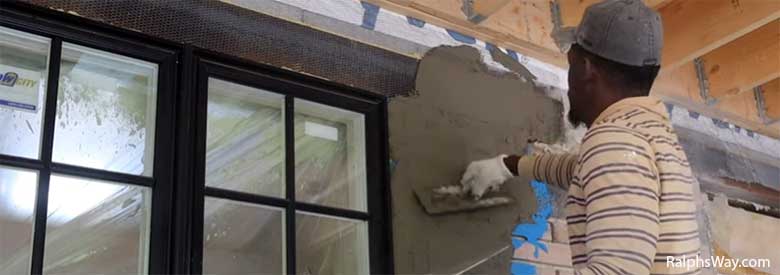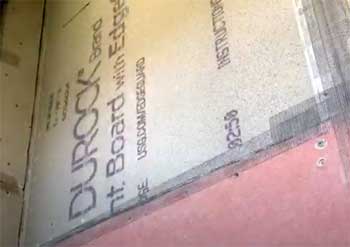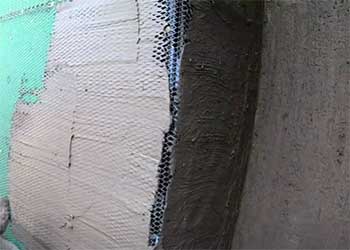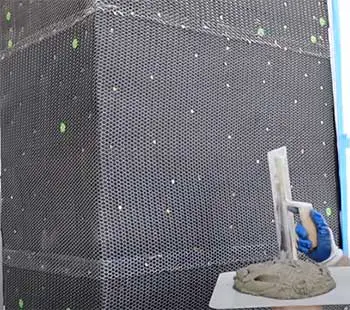We are all very familiar with stone veneer, right?
Whether it’s for exterior or interior design, everyone loves stone veneer because of its elegance. Stone veneer in the wall or floor has become common in modern architecture.
But when we think about the base of the stone veneer, it might bring some confusion. Metal lath and cement board are two pretty good options for stone veneer though both have some cons.
In this article, you will get a thorough analysis of metal lath vs. cement board.
Cement Board And Metal Lath: A Brief Overview

Metal lath is a kind of mesh made from various kinds of metal such as iron, steel, etc. Metal lath has different types- rib lath, sheet lath, diamond mesh lath, and wire lath are the most common ones.
Metal lath is widely popular for stone veneers because it helps the mortar to stick firmly with the stone. When metal lath is installed, its holes help capture the stucco and embed it properly.
Another useful thing for stone veneers is the cement board. Cement board is popular for stone veneers because of its water-resistance quality.
When the stone veneer is installed on the drywall, there’s a chance that the wall can wear off or moisture can affect the wall.
That is why a cement board is used for installing stone veneers. It saves the main wall and keeps the heavy stones away from it.
A Quick Comparison Table
Here’s a quick comparison between the metal lath and cement board for your better understanding-
| Specification | Metal Lath | Cement Board |
| Mortar | Type N, S can be used | Type M should be used |
| Use | Interior | Exterior |
| Material | Steel, Aluminium, Iron | 40-60% of cement, 20-30% of fillers, 8-10% of cellulose, 10-15% of mica |
| Strength | Holds the stones strongly | Strength increases when perfect mortar is used |
| Stone Type | Can hold heavy stones | Suitable for comparatively light stones |
| Price | Average Cost per Square Foot $1.53 | Average Cost per Square Foot $3.95, $5.40 |
Key Differences Between Metal Lath And Cement Board
Though both are used for the same purpose, you should know the key differences between them to choose the suitable one for your stone veneer.
Here are some key differences between metal lath and cement board in detail-
- Build Material and Structure

This is a basic difference between metal lath and cement board. You already know from the name that metal lath is made of various metals.
It is a rigid mesh with lots of holes in it.
The size and shape of the holes are different in different types of metal laths.
As the structure of the metal lath is very bumpy, it can hold heavy stones when a suitable mortar is used.
The materials of cement boards cannot be guessed by their name because the cement boards are not completely made of cement. Only 40% to 60% cement is used in cement boards; the rest portion is filled with various strengthening materials like cellulose, mica, etc.
- Mortar Types
Mortar is a kind of paste used in constructions to bond the stone, brick, tile etc., with the wall or floor. Cement board and metal lath require different types of mortar.
Type S,N and M has 5.1, 12.5, and 17.25 Mpa compressive strength, respectively.
As we knew earlier, metal lath is a kind of mesh with lots of holes and the holes help to hold the stones strongly. That’s why you can use type S and N mortar without any hesitation.
On the other hand, the surface of the cement board is very smooth. So, it would be difficult for the Type S and N mortar to hold the heavy stone against the wall.
In that case, it is recommended to use type M mortar for better grip.
- Interior/ Exterior
This is one of the key differentiating factors between the cement board and metal lath. When you will install the stone veneer for the exterior design, you should pick cement boards.
Cement board is generally used in the bathroom, kitchen wall/floor where the moisture level is high. Because cement board protects the main drywall from the excess moisture of those areas.
So, when you will use cement board in the exterior wall, it will protect the inside wall from being damp.
In the case of interior design, you can choose either cement boards or metal laths because you don’t have to worry about moisture. But if the stone is heavy, it’s best to pick metal lath for strong bonding.
- Stone Type

There are several types of stones available in the market.
Whether you should pick metal lath or cement board, depending on which kind of stone you will use for your stone veneer.
Bluffstone, Cliffstone, CoastalReef, Limestone, Longitude, Marquee, etc., are the most common stones for stone veneer.
Bluffstone, Cliffstone – these types of stones are the heaviest.
But Limestone, Longitude, etc., are comparatively thin and light. So when you work with heavy stones, make sure that you install metal laths.
- Installing
Installing your metal lath or cement board is the most crucial part of the stone veneer as the durability depends on the perfect base. Installing metal lath requires some other elements like a sheet underneath the lath and a wooden or aluminum frame.
First of all, cut the metal lath according to the size of your wall, and set it up with a few nails. Then plaster the metal lath, and your wall is ready for the stone veneer.
Cement boards are easier to install than metal laths. Cut the cement board with proper measurement, apply thin-set mortar on the rough side of the board, and stick it to the wall.
After it properly bonds with the wall, you can start the next step for the stone veneer.
Overview of Metal Lath
Metal lath is an open-weave mesh made from welded or woven thin metal wire, usually steel or galvanized steel. Traditional metal lath has a grid-like “diamond mesh” pattern with small openings that base coats can adhere to.
It has been used for decades as a base layer that plaster and stucco can grip onto.
Metal lath provides an excellent bonding surface for cementitious finishes and contributes impact, puncture, and fire resistance. However, plain steel mesh is prone to corrosion and rusting when used on exterior installations or in wet areas.
Galvanization applies a protective zinc coating to resist corrosion.
Metal Lath Pros

- Affordable – Metal lath is very economical, keeping material costs low even for large jobs. It can cost 50-75% less than cement boards.
- Lightweight – Standard diamond mesh laths weigh just 2.5-3.2 lbs. per square yard, minimizing loads.
- Highly Conformable – Metal lath can bend, shape, and conform to curved and irregular surfaces.
- Strong Impact Resistance – Metal lath is exceptionally resistant to blows and indentation. Solid metal resists penetration better than cement boards.
- Fire Performance – Excellent fire ratings up to 2 hours for firewall assemblies.
Metal Lath Cons
- Rusting/Corrosion – Unprotected steel lath will corrode and rust quickly. Must be galvanized for wet areas or exterior use.
- Difficult Tile Install – Cementitious bonding material and back buttering of tiles is required for difficult tile adhesion.
- Transfers Cracks – Provides no crack isolation, so movement cracks telegraph through the finish.
- Hard Physical Install – Installation is labor intensive, requiring furring strips and fastening through to studs.
- Can Deform – Light gauge meshes can deform during base coat application and may require re-straightening.
- Prone to Thermal Bridging – Conductive metal can transfer heat/cold easily through walls and cause condensation issues.
Overview of Cement Board
Cement board, also known as fiber-cement backerboard or tile backer, is a composite material panel consisting of sandwiched layers of cement and fiberglass mesh. Leading brand names include Durock, Hardiebacker, and FiberBond.
As their name suggests, cement backerboards were designed to provide a superior stable and bonded substrate for tile, thin brick, and stone veneer finishes, especially for wet areas like bathrooms and kitchen backsplashes. They are unaffected by moisture and will not rot or decompose.
Cement boards offer many great benefits that have made them a top choice for contractors and DIYers. Let’s look at the key upsides and downsides.
Cement Board Pros
- Waterproof – Impervious to water damage or mold growth, ideal for wet areas.
- Prevents Cracks – Fibers bridge cracks up to 1/8″, preventing transfer through tile.
- Lightweight – Around 2 lbs. per sq. ft., lighter than many substrates. Easier handling.
- High Bond Strength – Offers greater bond strength for finishes vs. drywall or plywood.
- Fire Resistant – Provides excellent fire resistance and won’t fuel flames.
- Uniform Composition – Consistent throughout, no knots, grains, or weak points.
Cement Board Cons
- Brittle/Prone to Breakage – Cementious matrix is rigid but more frangible than lath.
- Difficult Cutting/Nailing – Very hard on blades and drill bits. Special carbide scoring knives needed.
- Potential Delamination – Improper fastening or sealing can allow moisture ingress between layers.
- Not for Curves – Can only be installed on flat, stable substrates. Cannot conform to curved areas.
- Higher Material Cost – More expensive per sq. ft. than wire lath.
- Heavy and Unwieldy – Heavier than lath and difficult for one person to maneuver and install on ceilings & walls.
Frequently Asked Questions (FAQ)
Here are a few frequently asked questions about the metal lath and Cement board. Let’s read through to clear some confusion.
Yes, you can. But in that case, you have to apply a strong mortar on the cement board. You can also comb the layer of the mortar so that the surface gets uneven and it can hold the stone tightly.
A scratch coat is generally used on the metal lath to increase the rigidity of the metal laths. But if you use cement board, it is not compulsory to use a scratch coat.
Becker board is a type of cement board, made of cement and other reinforcement materials. The main difference between this two is that the becker board has fiberglass, making them more waterproof.
Metal lath is needed with cement board when you will install the stones on the corner areas. You cannot bend the cement boards. So, to fill the gaps in the corners, you must use metal laths. You can also use metal laths with cement boards in the entire wall for extra strength.
Yes. Because the cement board is porous. That’s why any type of mortar, cement, grout, thin set adhere well to these boards.
Final Words
Choosing the right base for the stone veneer is a very important task to do. When you install stone veneer for your house or any other constructions, you have to keep in mind what you’ll put under it.
People often get confused about metal lath vs. cement board and pick the wrong one for their stone veneer.
Go through the points discussed above and find the suitable solution for your stone veneer. Stone and mortar types, installing process- these factors should always be considered.

Is this article strictly about the decision *when using stone veneer?” I will be getting my bathroom tub-shower converted to a walk-in shower that will have *tile* walls.